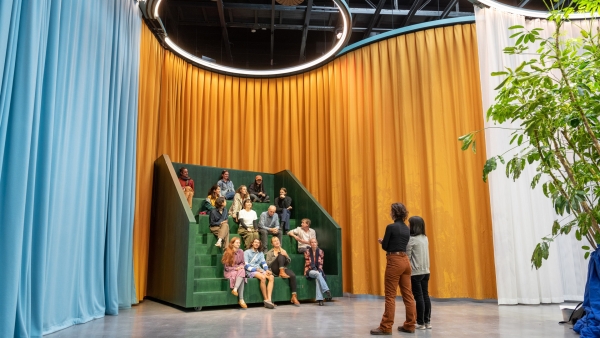The office boardroom is becoming a thing of the past as companies shrink their real estate and embrace hybrid work.
Companies are cutting costs by hiring local meeting spaces on demand rather than have them in-house. For larger gatherings, the conference centre typology is also due a rethink. Those stifling out-of-town box buildings that people travel miles to visit for a few days aren’t only unsustainable but have questionable impact on our wellbeing. With renewed focus on the value of meeting in person, is there a more sensible, healthy and inclusive way to plan these spaces?
Meeting space on demand
While not everyone lives the life of a digital nomad, we have been getting used to doing more of our work wherever we happen to be. Global demand for meeting rooms within flexible office space is up 73 per cent since 2020, reflecting the fact more companies are utilizing meeting space only where and when it is needed. Providers like US-based Convene are building on this demand by offering a variety of physical meeting spaces with hospitality-style service that includes event management, F&B and tech support. Head of design Katie Timmerman told us the in-person get-together has an elevated meaning in an era of hybrid work, requiring spaces to deliver a level of comfort and functionality that’s worth leaving home for.
A strategic location is everything to an on-demand meeting room, which is why we’ll see more popping up in or near key transport nodes, and as added functions within institutions and public buildings. Close to two large universities in Hangzhou, The Arcade conference centre by Superimpose is a suite of classrooms, meeting spaces and auditoriums tucked away in the basement of a mixed-use development with commercial space and serviced apartments above. During the COVID-19 pandemic, the meeting rooms provided a way to continue in-person learning between the professors and students who live in the complex. As more restrictions lift, the spaces will appeal to companies looking to save costs by renting meeting space rather than owning it, in one of China’s most expensive cities.
Less space, better used
With the option for employees to dial in or be physically present, the footprints for meeting and conference spaces needn’t be so large. Advances in broadcast technology make the experience of streaming a conference at home comparable to the real thing. In-person meetings and gatherings could be nimbler, taking up disused space like retail units or temporary structures. San Francisco-based company ZenSpace installs standalone meeting pods on underused space in shopping malls, airports and hotels that cater for four to 20 people. Meanwhile, Little Finlandia is a demountable timber pavilion used as a meeting and event space while Helsinki’s iconic Finlandia Hall undergoes renovation. The 2,200-sq-m structure can hold meetings for up to 1,100 people or dinners for 800. Its modules will be disassembled and re-purposed after use with an intended lifespan of 50 years.
Conference centres are built to accommodate thousands of guests but are only used over short periods. They are also typically insular and energy-intensive to run, relying on artificial lighting and ventilation. Plans for the new ConFex Park in Thessaloniki will turn that idea on its head, by setting a series of stacked indoor and outdoor event spaces around a large, landscaped park. The central location means the use of the site can be intensified with public activity as well as international events. MVRDV's Ton 1 project at Atelier Gardens in Berlin also features flexible for-hire space within a more inspiring setting. The former film studio has been transformed into a campus with multiple uses and a focus on biodiversity.
The ‘bleisure’ effect
With remote work and conscious travel on the rise, more people are combining business trips with leisure over extended stays. That’s driving demand for conferences with awe-inspiring architecture in coveted destinations. MAD Architects' Yabuli Entrepreneur’s Congress Centre is a 16,000-sq-m meeting complex situated in a popular ski town. Under an organically-shaped roof – clad in white aluminium panels to mimic the snow – is a cavernous timber-lined interior lit dramatically by a central rooflight. The technology to make this building of various meeting spaces work is hardly seen, with screens and stages that retract to give views of the surrounding mountains.
The profile of a typical ‘bleisure traveller’ is changing too. Digital nomad families are increasingly enabled by hybrid work and tend to stay longer in a location visited for work than their solo counterparts. Lonely Planet surveyed 1,400 ‘anywhere workers’ of 67 nationalities, finding 70 per cent were parents who took their children with them on their travels. That change in audience, along with the need to make conferences more accessible to working parents, is driving demand for family-friendly events and venues. The recent H22 City Expo in Helsingborg, Sweden made children and families an important part of the programme, inviting all perspectives on sustainable city design.
While state-of-the-art tech, inspirational design, and a strategic location will always be high on the list for event organizers, slick hospitality, access to nature and a family focus are increasingly important parts of the mix.
________________________________________________________________________________________________________________________________________________________
▪ Source: FRAME|https://www.frameweb.com/article/work/how-is-hybrid-work-changing-meeting-and-conference-spaces
▪ Words: RIYA PATEL
▪ Photography Credit: ©KIMMO RAISANEN, ©STEFAN KORTE, ©ARCHEXIST


